The AMD Trinity Review (A10-4600M): A New Hope
by Jarred Walton on May 15, 2012 12:00 AM ESTAMD Trinity Gaming Performance
After the 3DMark results, you might be wondering if Intel has finally caught up to AMD in terms of integrated graphics performance. The answer is…yes and no. Depending on the game, there are times where a fast Ivy Bridge CPU with HD 4000 will actually beat out Trinity; there are also times where Intel’s IGP really struggles to keep pace. The good news is that at least everyone is now onboard the DX11 bandwagon, and compatibility with games has improved yet again for Intel. Here are our “Value” benchmark results for seven recent games; we’ll have more information in a moment.

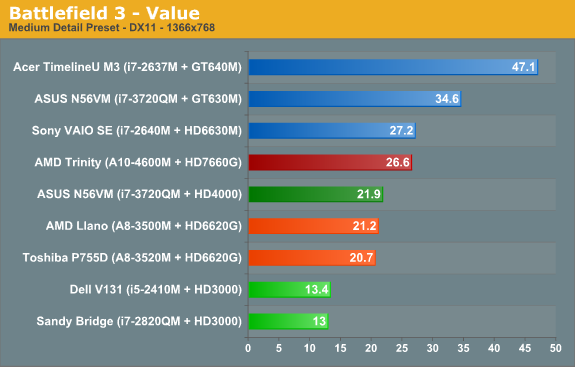
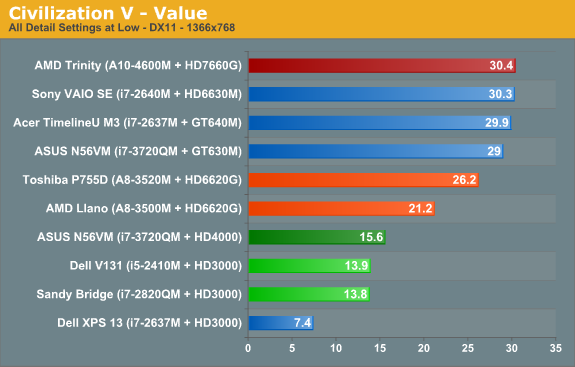

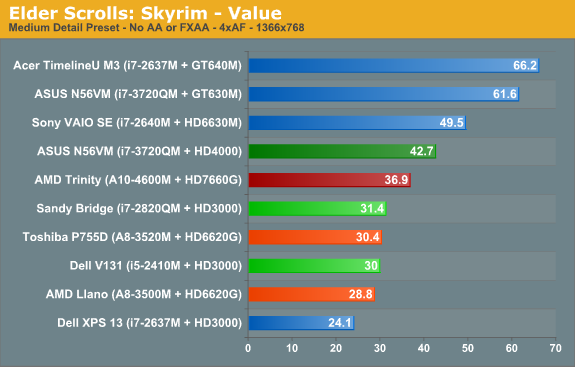
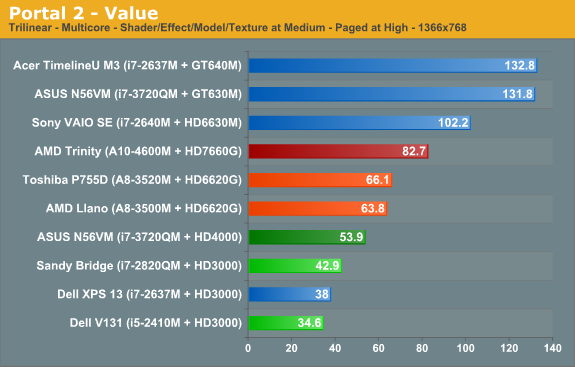
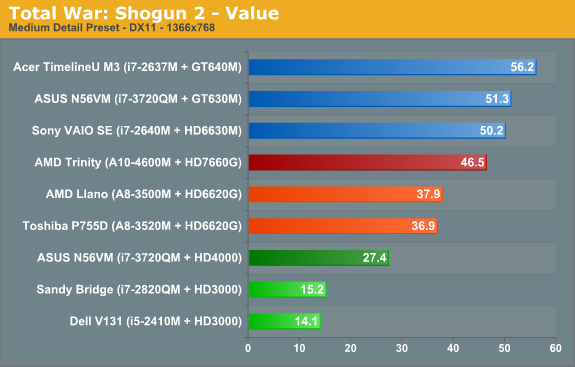
Out of our seven test titles, AMD’s Trinity leads any other IGP in four titles by a large margin. The other three titles actually have Ivy Bridge slightly ahead of Trinity, but the gaps aren’t nearly as big. Overall, the average performance across the seven games at our Value (medium) settings has AMD’s Trinity A10-4600M leading Intel’s i7-3720QM by 21%, and if we look at quad-core Sandy Bridge with HD 3000 (i7-2820QM) Trinity is 72% faster. Trinity is also around 20% faster than 35W Llano on average.
Let’s expand our gaming suite just a bit to see if things change, though. Just like we did with Ivy Bridge, we ran the eight games in our previous benchmark suite at medium detail settings. We can then compare performance across a wider 15 title selection to see how Trinity matches up against HD 4000, HD 3000, and HD 6620G (Llano). We’ll start with the bottom (HD 3000/Sandy Bridge) and move up.
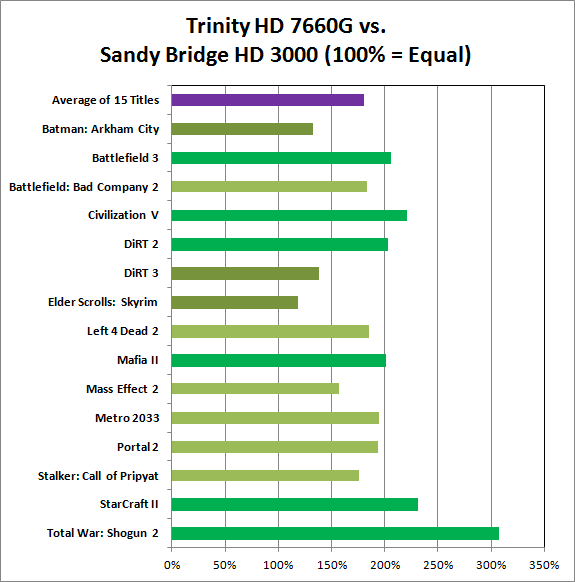
Llano’s HD 6620G was already faster than HD 3000, and Trinity’s HD 7660G is faster than Llano, so the Sandy Bridge gaming matchup is a landslide victory in AMD’s favor. The closest Intel can get is in the same three titles where Ivy Bridge leads Trinity: Batman: Arkham City, DiRT 3, and Skyrim. Here, however, HD 3000 can’t actually close the gap and HD 6620G is at least 20% faster than HD 3000, with an average performance improvement of nearly 80%.
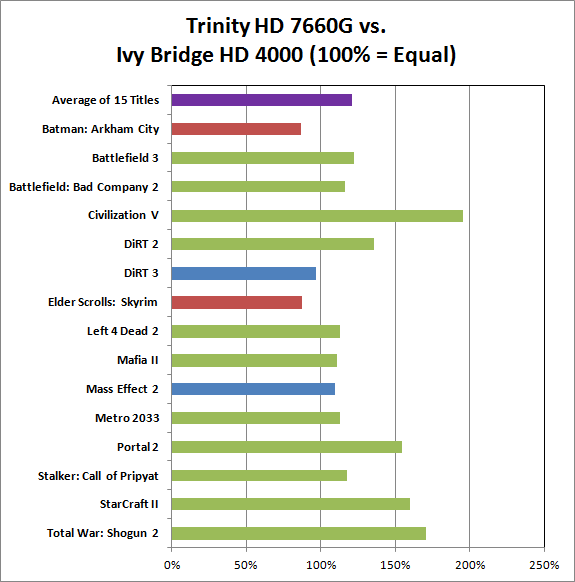
We found that across the same selection of 15 titles, Ivy Bridge and Llano actually ended up “tied”—Intel led in some games, AMD in others, but on average the two IGPs offered similar performance. This chart and the next chart will thus show a similar average increase in performance for Trinity, but the details in specific games are going to be different. Starting with Ivy Bridge and HD 4000, as with our earlier game charts we see there are some titles where Intel leads (Batman and Skyrim), a couple ties (DiRT 3 and Mass Effect 2), and the remainder of the games are faster on Trinity. Mafia II is close to our <10% “tie” range but comes in just above that mark, as do Left 4 Dead 2 and Metro 2033. The biggest gap is Civilization V, where Intel’s various IGPs have never managed good performance; Trinity is nearly twice as fast as Ivy Bridge in that title. Overall, it's a 20% lead for Trinity vs. quad-core Ivy Bridge.
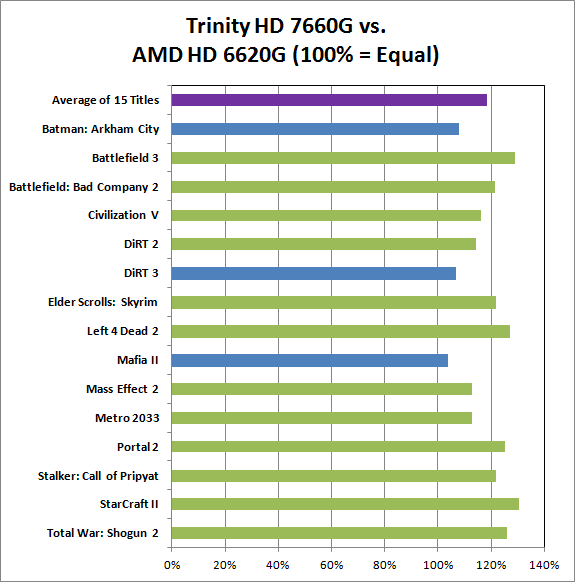
Against Llano, Trinity is universally faster, but the smallest gap is in Mafia II (3%) while the largest gap is in StarCraft II (30%). On average, looking at these games Trinity is only 18% faster than Llano. What’s not entirely clear from the above chart is whether we’re hitting CPU limitations, memory bandwidth limitations (remember that Llano and Trinity share bandwidth with the rest of the system), or perhaps both. At our chosen settings, what is clear is that Trinity’s “up to 56% faster” graphics never make it that high.
We saw 35-45% higher scores in 3DMark 11 and Vantage, which tend to remove the CPU from the equation more than actual games, so our guess would be that if AMD continues with their APU plan they’re going to need to work more on the CPU side of the equation. We also see the same thing looking at the VAIO SE scores in the earlier gaming charts: the HD 6630M scores are 20% faster on average, but much of that appears to come from the faster CPU rather than the GPU.










271 Comments
View All Comments
medi01 - Friday, May 18, 2012 - link
Somehow one doesn't wonder at tomsharware, that comparing chips with vastly different price is a bad idea.TC2 - Sunday, May 20, 2012 - link
amd cpu is far behind intel cpu! about gpu! nvidia is also far better as performance & software support! so for professionals and buyers with budget there isn't point to go with amd! :)))but for amd - as good as is get :))) sorry
kevmanw430 - Tuesday, May 22, 2012 - link
Jarred, what version of Skyrim was tested? Bit of a question in a forum discussion, would like to know.Thanks!
JarredWalton - Wednesday, May 23, 2012 - link
Running the Steam variant, so it's automatically updated. At time of testing, I believe it was version 1.4 (with high res texture pack). The tested sequence is in the area of Whiterun, as I found in initial playing (on a desktop) that it was one of the more demanding areas. I wanted to find the "worst case" situation for playing the game, so that if you get >30 FPS in our benchmark, you'll generally get >30 FPS throughout the game. There's a reasonable chance that other parts of the game are less CPU intensive and thus might show Trinity in a better light, though it's debatable whether that's more or less meaningful than the current results.seapeople - Tuesday, May 22, 2012 - link
Why do you even read computer reviews then? Every single review I've ever read in my life on any site ever created includes a new, top of the line product in the graph REGARDLESS of what's being reviewed. It's not bias, it's not inattentiveness, it's not even remotely absurd as you state, it's quite simply expected for computer reviews.seapeople - Tuesday, May 22, 2012 - link
This is quite silly. We're not comparing a $90,000 Mercedes to a $16,000 Hyundai, we're comparing a processor that might be in an $800 computer to one that might be in a $600 computer based on how sales are at any particular point in time.It's amazing that two or three negative posters account for roughly 50% of the comments on this thread. Somebody is trying too hard.
Stradi - Friday, May 25, 2012 - link
I'm a bit confused about how this review was done. Are they comparing the APU without the extra discrete GPU against intel Ivy Bridge with discrete GPU from nVIDIA and saying the Ivy Bridge is better for gaming? or is this comparing the APU with AMD's discrete GPU that's on crossfire against intel/nVIDIA setup?I assumed the crossfire setup will actually prevail against ivy bridge/nvidia in terms of gaming. I was waiting for Trinity not because it's got a decent GPU in there, but it gives you the option to crossfire with AMD's discrete GPU. And while I like the nVIDIA's discrete GPU option, I didn't think it can havest the intel HD 4000 graphics power and add to it.
I need some clarification on this. I hope they didn't mean to compare an AMD's new APU with Intel's latest+nVIDIA's latest. Why would any reviewer think that'd represent a fair comparison? why would they put an extra discrete GPU in one machine and say that's a better gaming machine?
rarson - Tuesday, May 29, 2012 - link
The AMD APU is not paired with a discrete APU.Obviously the review is confusing and full of incongruous comparisons, but Jarred and Anandtech aren't going to fix it.
rarson - Tuesday, May 29, 2012 - link
Anandtech now responds to criticism by simply deleting it. Or was that Jarred's doing?R3MF - Friday, June 1, 2012 - link
the slides say OpenCL 1.1, will full support in hardware for 1.2 arrive?